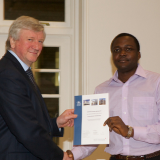Brief Answers To The Big Questions (2018) Book Summary & Insights
Book Title: Brief Answers To The Big Questions
Subtitle: Hawking’s Final Thoughts On The Biggest Questions Facing Humankind
Publication Date: 2018
Author Name(s): Stephen Hawking
About The Author
Professor Stephen Hawking was the successor to Albert Einstein. He was a renowned scientist known for his interest in cosmology and physics. At the time of his death, Hawking was director of research at the Centre for Theoretical Cosmology at the University of Cambridge.
More than being a brilliant scientist, Hawking motivated millions with his decision to move forward after his diagnosis of ALS — which steadily deteriorated his motor skills until he could communicate using just a few facial muscles.
Hawking stood by his belief that most of the universe’s problems could be fixed with science, and answered the world’s big questions.
Brief Answers to the Big Questions is only one of Hawking’s many books, where he addresses the mysteries of the universe and theories of creation.
He is the recipient of many awards and accolades, including the Presidential Medal of Freedom, the 2015 BBVA Foundation Frontiers of Knowledge Award, and the lifetime achievement award at the 2015 Pride of Britain Awards.
Book Summary
This book is for anyone curious about how the earth came to be, people searching for answers to some of the universe’s biggest questions, and anyone else looking to gain more knowledge of the world.
Who Is This Book For?
This book is for anyone curious about how the earth came to be, people searching for answers to some of the universe’s biggest questions, and anyone else looking to gain more knowledge of the world.
Buy Book: Support The Book Author(s) And Our Work
Great books should be read, studied, and reviewed frequently, so reading the actual book may provide more value to you than the book insights on this page. Besides, this would support the work of the book author and what we do on LarnEdu. What could be better?
Important Notes
We get a small compensation from Amazon when you visit your nearest/local Amazon site via our affiliate link to purchase an item within 24 hours or if you add it to your cart and checkout within 90 days. This is no additional cost to you and supports our work.
The information on this page is meant to supplement the actual book(it is not a book review but distils the key insights or ideas from the book in under 5000 words). The content creator or LarnEdu does not necessarily support the views, thoughts, and opinions expressed in the text/book. Reasonable skepticism should be applied with any views, thoughts or opinions expressed/shared by the book author or content creator.
Reading the contents of this page does not guarantee specific results. The best lessons are achieved from taking consistent action in the real world rather than being addicted to the illusion of progress by getting stuck on reading an infinite amount of books orbook summaries and insights. LarnEdu and the content creator accepts no responsibility or liability for the accuracy of the information on this page or how it is used.
Book Insights

What Is The Relationship Between Religion And Science?
Do you ever take a moment out of your day to pause and think about the beginning of all creation? – the why, how and when?
Religion answers these questions well enough for most, but science neatly counters the claims religion makes. On one hand, science makes says everything concerned with life and human destinies are accidental, and subject to other defining factors.
Religion proclaims that a Supreme Being dictates the meaning of human life. We can trace the basis of these claims to the earlier years. Then, man’s need to explain everything away as having to do with the gods was strong. Man believed gods controlled everything from eclipses to lightning. As science took over and technology grew, the skeptic minds questioned the rationality of these ultimate beings. Scientists eventually came to this conclusion: unbreakable, natural laws govern our universe, and it runs more like a machine.
Since we cannot break natural laws, this theory completely denounces the possibility of the existence of God, as religion presents God as omnipotent.
As with any two conflicting theories, we can reconcile science and religion to reach an agreeable definition. Einstein refers to God as “a reference term for the observable, unbreakable rule of the cosmos” He says we should view God -if we must believe in a God- as a part of the laws of nature, and not a Supreme creator.
We picture God as a Being overseeing all, and this theory would not sit well with many people. Science calls us to forget all sentiments and see human life as the accidental occurrence it is. Once we cast all predispositions aside, we realize that a divine creator is the least likely answer to how we came to be.
The Big Bang
So, if we denounce all notions of God, how did the universe and we come to exist in the first place?
Have you ever heard of the Big Bang? It is a theory that claims our universe came to being in little more than a nanosecond. The universe previously existed as an infinitely dense point and suddenly expanded into the growing body it is today.
Edwin Hubble was the scientist who discovered the theory of the Big Bang. His quest to this conclusion began in 1929 when he analyzed distant galaxies and light to measure the movements of these galaxies – if there were any.
Hubble’s analysis led him to discover that galaxies were in fact moving farther away from each other and, the faster moving ones were those farther from Earth. The calculation of speed and distance led to the conclusion that, 10 to 15 billion years ago, these galaxies must have been close enough to be considered a singularity.
If scientists discovered all these, what came before the Big Bang? Einstein tries to provide an answer to that with his theory of “space-time”. The concept is overwhelming, so, we can contemplate it by looking at the start of the universe. The cosmos contracted to a dense singularity resembling a black hole where all notions of space and time ceased to exist.
This shows that the Big Bang may have caused our universe to exist but nothing caused the Big Bang. We come to this conclusion because time did not exist.
Alien Life
The concept of aliens and extraterrestrial life has been an object of much speculation for the movies, books, and conspiracy theorists for decades. There is no easy way to disregard all claims to extraterrestrial sightings/encounters, and no way to fully back the claims either.
Therefore, we can only speculate that if the Earth has evolved to where it is now, without existing for as long as some other planets, alien life form could very well have risen. The universe was already seven billion years in existence by the time the Earth came into being, giving other life forms ample time to have reached their full potential before man built the first fire.
Other planets as habitable as Earth would also arise in talks concerning alien life. Scientists estimate that 20% of stars in the entire universe have a region known as the “Goldilocks Zone” which is similar in ways to the Earth.
Since we have about 200 billion stars in our Milky Way, this means we have about 40 billion habitable places in our neighbourhood. Then why have aliens not visited us yet? Well, although we have accepted alien life as plausible, there are still some speculations as to the existence of intelligent life. Life on Earth took 2.5 million years to get where it is today–intelligent life made up of multi-celled organisms.
Our Earth and any other planets face the threat of exploding stars and suns much like the one that cleared out the dinosaurs 66 million years ago. There is a possibility that habitable planets could have been developing and then suffered an asteroid collision.
Predicting The Future
Imagine for a minute you could predict the future, all the good fortune that would come your way. Now, snap out of that dream world and think how possible you predicting the future is. French scientist, Pierre-Simon Laplace is of the notion that knowing our state at a given time allows us to have a chance of predicting the future to a reasonable extent.
Laplace’s notion did not last long, though. In the twentieth century, Werner Heisenberg proved that to measure both the speed and position of a particle, there would have to be an inaccuracy in one. This led to the discovery of the uncertainty principle, which changed the way physics viewed the world.
So, quantum mechanics was born. Particles do not possess properly defined speeds and potions in quantum mechanics. Instead, they stand as a thing called “wave function”, which is a set of numbers representing the different points in space. Quantum mechanics has allowed for more accurate predictions and estimates but it comes with its own problems. For example, we cannot predict the speed and position of a particle; we can only calculate its wave function.
The Concept Of Black Holes
Black holes come into existence when a star collapses. The gas and mass in the stars cause a large gravity pull — and the larger mass involved, the bigger the gravity pull.
Black holes come into existence when a star collapses. The gas and mass in the stars cause a large gravity pull — and the larger mass involved, the bigger the gravity pull.
Our sun is a star, but it has not collapsed in on itself. This is because a star creates thermal pressure, which works as a support against its gravity. This thermal pressure protects it from collapsing only for a period, though. When a start runs out of nuclear fuel, it draws surrounding matter into itself and contracts into a singularity — which is the black hole.
Once anything crosses the boundary of a black hole, there is no way to pull back out. However, some things can escape the pull of a black hole.
Stephen Hawking discovered in 1974 that black holes release particles at a steady rate and, space is filled with particles and antiparticles. His theory suggests that the particles are in constant interaction – bonding, separating, and destroying one another. He says this interaction causes black holes to disappear eventually from losing mass.
The Earth And Impending Doom
Many threats face our planet in more ways than we can imagine. All signs show that the end is near and will be unfavourable for Mother Earth. Physics and probability laws prove that Earth should have been hit by another asteroid collision similar to the one that ended the dinosaurs.
No matter how technologically advanced we get; there is little we can do to prevent this, eventually. Therefore, we should focus more on stopping the stoppable — climate change. We need to find a workable solution to what we know as the “greenhouse effect” if we mean to control the climate situation. If not, we could well end up as inhabitable as the planet Venus, with its weather highs of 250 degrees Celsius.
The way things are going, the chances of Earth meeting its end by either environmental disaster or nuclear war within 1,000 years is high.
With the fix we are in, we should look into colonizing other planets habitable to us. Space is an area grossly under-explored. The government and politicians do not channel funds readily into that area because; people in power believe there are things that are more important.
Man is; however, curious by nature. Once the government or other agencies put deadlines in place for space agencies’ space exploration, results will flow in. Then, once these successes come in, the public’s interest and technology will grow.
Scientists say with the current growth of our technology, by 2050, a moon base should be possible, and by 2070, a Mars landing would be possible. We could also explore the planets of our solar system, even if we would not go further for a very long time.
Even though we have the problem of properly exploring other solar systems because of distance and time, there is the option of unmanned crafts. If scientists could properly invest their resources and develop technology, we can reach heights previously unimagined.
Artificial Intelligence
The movies have depicted what artificial intelligence can do, and we had Arnold Schwarzenegger to save the day in Terminator.
We need to consider that artificial intelligence is a big enough threat to us. Our brains are far more complex than our most advanced computers today but there is the potential for self-improvement. Artificial intelligence may be the answer to a lot of humanity’s problems and questions when used right. We already have self-driving cars and revolutionary computers and just think about where we could be in the next hundred years, if they continuously grow in speed, capacity, and power.
The most important thing we should remember is that we make machines to serve humans and not the other way. Once we are well aware of the dangers of uncontrolled artificial intelligence, we will be okay.
Key Quotes
Here’re some key quotes from the book:
“So remember to look up at the stars and not down at your feet. Try to make sense of what you see and wonder about what makes the universe exist. Be curious. And however difficult life may seem, there is always something you can do and succeed at. It matters that you don’t just give up. Unleash your imagination. Shape the future.”
“The human race does not have a very good record of intelligent behaviour.”
“I don’t believe in boundaries, either for what we can do in our personal lives or for what life and intelligence can accomplish in our universe. We stand at a threshold of important discoveries in all areas of science. Without doubt, our world will change enormously in the next fifty years. We will find out what happened at the Big Bang. We will come to understand how life began on Earth. We may even discover whether life exists elsewhere in the universe. While the chances of communicating with an intelligent extra-terrestrial species may be slim, the importance of such a discovery means we must not give up trying. We will continue to explore our cosmic habitat, sending robots and humans into space. We cannot continue to look inwards at ourselves on a small and increasingly polluted and overcrowded planet. Through scientific endeavour and technological innovation, we must look outwards to the wider universe, while also striving to fix the problems on Earth. And I am optimistic that we will ultimately create viable habitats for the human race on other planets. We will transcend the Earth and learn to exist in space.
This is not the end of the story, but just the beginning of what I hope will be billions of years of life flourishing in the cosmos.
And one final point—we never really know where the next great scientific discovery will come from, nor who will make it. Opening up the thrill and wonder of scientific discovery, creating innovative and accessible ways to reach out to the widest young audience possible, greatly increases the chances of finding and inspiring the new Einstein. Wherever she might be.
So remember to look up at the stars and not down at your feet. Try to make sense of what you see and wonder about what makes the universe exist. Be curious. And however difficult life may seem, there is always something you can do and succeed at. It matters that you don’t just give up. Unleash your imagination. Shape the future.”
Conclusion
Humanity is naturally curious, and our curiosity has led us to ask and answer some of the most important questions surrounding our existence. Professor Stephen Hawking encourages us to ask questions that are more complex like the workings of black holes and consequences of uncontrolled artificial intelligence.
Since You’re Here…
Great books should be read, studied, and reviewed frequently, so reading the actual book may provide more value to you than the book insights on this page. Besides, this would support the work of the book author and what we do on LarnEdu.
You can also support the work we do at LarnEdu work by making a one/off or monthly donation(via PayPal) for as little as £0.99 or sharing this content.
Do you have any feedback or suggestions? Use the comment section below or send us a message.
Content Created By: Tracy















